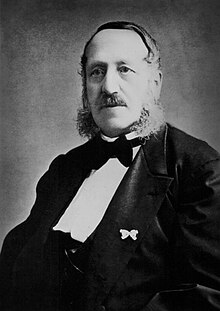Moritz Faithful to God
Moritz Wilhelm Gottgetreu (born September 22, 1813 in Swinoujscie ; † February 26, 1885 in Potsdam ) was a German architect and court architect in Potsdam.
Life
Moritz Gottgetreu was the son of the harbor designer and master builder Gustav Adolf Wilhelm Gottgetreu. After studying with Karl Friedrich Schinkel, among others, at the building academy in Berlin , he became a master builder at the Royal Garden Directorate in 1844 and worked under Ludwig Persius as a builder for fountain construction in the court building commission from 1845–1846. In 1840 he joined the Berlin Architects' Association .
In 1849 Moritz Gottgetreu received the title of court architect and in 1851 that of court building inspector in Potsdam. Appointed court building officer in 1861, he died as a secret court building officer in Potsdam in 1885. His brothers Rudolf Wilhelm and Gustav Adolf (1812–1890) also worked as architects. The first name "Martin" mentioned very often in the literature can be traced back to a wrong secondary source and is not applicable.
His son Gustav Adolf Moritz Gottgetreu (born November 16, 1846 in Bornstedt near Potsdam, † October 7, 1911) became court gardener in Rheinsberg.
architecture
The buildings of Moritz Gottgetreu belong to the Schinkel School according to his training in Berlin and his field of activity in Potsdam . His main tasks were building construction, especially of Ludwig Persius' designs. Faithful to God was an expert in fountain and irrigation systems and as such worked for King Friedrich Wilhelm IV in Sanssouci and Prince Wilhelm in Babelsberg Park . In addition, numerous outbuildings and park architectures were created in Babelsberg based on his designs.
In the Berlin suburb in Potsdam, the merchant and sugar boiler owner Eduard Tummeley had a villa built on the banks of the Havel from 1847–1848 according to plans by Gottgetreu. The Villa Tummeley, with its yellow brick façade and decorative forms in the Tudor Gothic style, corresponds to the buildings in the Babelsberg Park opposite. Its structure is based on the mass structure of the Small Castle, which is also located on the bank.
Buildings (selection)
- Babelsberg Park, steam engine house, 1843–1845, built according to Ludwig Persius
- Babelsberg Palace , second phase of construction, 1845–1849, construction carried out by Ludwig Persius and Johann Heinrich Strack
- Potsdam, Villa Tummeley, 1847–1848, preserved modified
- Babelsberg Park, conversion of the coach house, 1850
- Anklam , grammar school , 1852
- Neuhardenberg , renovation of the castle , 1852
- Park Babelsberg, greenhouses of the court gardening company, 1855–1865
- Klein Strehlitz , Dobrau Castle, reconstruction 1856–1858, preserved as a ruin
- Potsdam, Villa Gottgetreu, 1858, not preserved
- Babelsberg Park, Kitchen House, 1859–1860
- Babelsberg Park, two gatehouses, 1865, one on Alt Nowawes Street
- Berlin, residential building Lindenallee 7, 1867–1868, not preserved
Publications (selection)
- The steam engine house and the fountains on Babelsberge near Potsdam , Allgemeine Bauzeitung 11, 1846
- The Fontainen-Bau zu Sans-Souci , Berlin 1854
- Babelsberg Castle (with JH Strack), Berlin 1857
literature
General artist lexicon (AKL). The visual artists of all times and peoples Vol. 59. KG Saur, Munich and Leipzig 2008, ISBN 978-3-598-22799-8 .
Web links
Holdings of the architecture museum of the TU Berlin
Individual evidence
- ↑ Steffen Orgas: "... nothing worth mentioning" in Anklam - a Schinkel student corrects his master. Moritz Gottgetreu's Anklamer grammar school. In: Cultural heritage in Mecklenburg and Western Pomerania. Born 2006, Schwerin 2007, ISBN 978-3-935770-17-0 , p. 45
| personal data | |
|---|---|
| SURNAME | Faithful to God, Moritz |
| ALTERNATIVE NAMES | Gottgetreu, Moritz Wilhelm (full name) |
| BRIEF DESCRIPTION | German architect and court architect in Potsdam |
| DATE OF BIRTH | September 22, 1813 |
| PLACE OF BIRTH | Swinoujscie |
| DATE OF DEATH | February 26, 1885 |
| Place of death | Potsdam |
